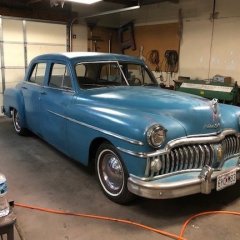Leaderboard
Popular Content
Showing content with the highest reputation on 09/21/2013 in all areas
-
I've never written a blog before, but I do have the ability to share what's on my mind to those who will listen. So I guess this is the same thing, only different. To be a blogger, I can see a need to be somewhat entertaining as well as informative. In other words, make sense and don't turn it into a dang lecture about what I think is right or wrong. Yet, to do that, it might be helpful to have an artist's "eye" to create something people can enjoy, without feeling patronized. Lord knows I'm not starting my entries out with opening lines like "Dear Diary" or "You know"....I just can't put that kind of pressure on myself. I will do what I can with "the writer" I might be, "the thinker" inside us all, and the artist I actually am. I can only share how I see things.....really....that's it. I'm not an analyst, reporter, or anchorman. I am the man on the street who never got his interview. So here I am. This is my marker. I'm gonna go think of stuff, try and create an idea, then write it down.......should be fun.2 points
-
One of the quickest ways to get a quick health check on your electrical system is watch your ammeter! It will tell you all kinds of valuable information if you know how to read it! Most modern cars now use a voltmeter to provide limited information about your electrical system. Or even worse just a warning light to let you know your alternator has failed. Because voltmeters are now the norm the skill of interpreting the information the ammeter provides is becoming a lost art. Let’s walk through a driving sequence to understand what the ammeter will reveal about your electrical system. Entering the car your the ammeter should be reading "0", straight up. You may see a quick defection to the minus side if your have an interior light that comes on with opening the door. It's at "0" because you are not using any or generating any current (engine is not running). When you turn on the ignition you will see the needle move slightly to the minus (discharge) side indicating a discharge of a couple amps. This means your ignition system is getting power. When you hit the starter the ammeter will deflect sharply to the left (minus 20-30 amps) as the starter spins. The energy for the starter is being drawn straight from the battery. As the engine fires the ammeter will quickly move to the plus side (charging) of the gauge in the 20-30 amp range. The energy that was drawn down from the battery while starting is quickly being replaced by charging current from the generator. As you start driving the voltage regulator will manage the amount of charge needed to go back into the battery. After around five minutes of driving typically the battery will start to approaches full charge and you will see a reduction of charge rate down to 1-3 amps on the plus side. At this point the battery has fully recovered from the starter discharge and now the generator is putting out only enough current to maintain the charge. The voltage regulator manages the on-going charge rate. While your driving night time is coming and it is getting cooler. You turn on your headlights and start up the heater fan. Immediately you see the needle momentarily jump to the minus side, then come back to 1-3 amps on the charge side as the regulator manages the generator output to meet the increased demand. As you come to a stop sign and the engine speed drops, the ammeter will move sharply to the minus side, often 15-20 amps down. You notice the lights dim and the heater motor may slow. Right now your generator is not creating enough power to offset the increased load of the headlight and heater motor and is drawing backup power from the battery. This lack of sufficient power generation can fully discharge a battery if allowed to go for a long period. The short stop at the stoplight however, is not harmful. In fact, you can always bump the manual throttle to bring the idle up enough to stop the discharge. As soon as you accelerate from the stop the generator will again start generating sufficient current to replenish the energy pulled from the battery (expect a jump to 5-10 amps charge for a short period) before settling back to a trickle charge of a couple amps while driving. So how can you use if for some basic troubleshooting? When you first get in and step on the break pedal, the ammeter should deflect slightly to discharge as the brake lamp lights. This lets you know the battery has some charge. No deflection? Battery is probably dead or disconnected. Also when you turn on the key if you don't see a slight discharge indication your ignition is probably not connected or functional. If when turning on the key and immediate your have a full discharge (minus 35 amps) you have a dead short that needs to be repaired. Immediately turn off the key and begin trouble shooting to find the electrical short. Otherwise you risk the very real danger of a wiring fire. Might start your troubleshooting at the headlight switch as they have historically been trouble spots due to corrosion resistance in the connectors. If you are running and suddenly see a continuous discharge usually this indicates a voltage regulator issue. Try tapping the regulator case with a screwdriver handle to see if a relay is sticking and it starts charging again. On teh other hand if you see a continuous rate of high charge (> 20 amps) that never goes down you may have a battery starting to fail (it's not taking or holding a charge) or a voltage regulator failing. Either way it's time to troubleshoot the generator and regulator charging circuit. By watching the action of your ammeter your can easily tell if your electrical system is functioning correctly. It will tell you if you have a short, your battery is full charged, how fast it is charging and how much current your are consuming while driving. Compared to a voltmeter which simply gives system voltage, ammeters allow you active monitor your electrical system. Share what on the road lessons have you learned by paying attention to your ammeter!1 point
-
six volt items were made to handle X current based solely on the preset ohm value of the winding. This very resistance with applied 12 volts causes for a dramatic increase on current drain..(ohms law)..thus long term application of voltage I would not recommend...the voltage changes but the resistance does not. Knowing the resistance and voltage one gets the wattage (volts x current) so one needs to select the proper rated resistor for ohms and wattage inline ahead of the solenoid and drop the voltage in half (this requires a very accurate meter to get the ohm value or better yet, check current draw with 6.8-7.2 volts applied) and thus the device sees only the current it is normally rated for...the resistor needs to be of ample wattage to displace the heat without causing internal failure of the resistor.. so just for exercise this example...... 7.2 v / 5 ohms solenoid winding (nominal output of generator) 1.44 amps 14.2 v / 5 ohms solenoid winding (nominal of alt) 14.2 amps...2.84 amp (voltage x current = wattage) so to select a resistor for above example one will need 5 ohms and hopefully anything above 11 watts remember..you are looking to operate the device at the given original voltage...thus we select the original values to add inline to consume and dissipate the heat ahead of the device..the higher the wattage rating, the hotter the resistor will get..be sure you have adequate place to hang and allow for the heat to be dissipated...1 point
-
I bought a project for 20 bucks and a 12 pk, also asked what brand. Beer currency also works in WI.1 point
-
He laughed told me the trans was good in that truck and told me 2 case of beer. (common Canadian currency) I restarted my hockey career last fall at age 47 and paid 12 beer for my equipment.1 point
-
I talked to the woman at the office today and she called the owner and explained I was interested in the old truck out in the field. He said to me right away before I could say hello I don't want to sell that truck I need it to hold my sign. So I said I don't need the truck just the transmission. As polity as I could before he hung up on me. He paused for a second and said how do you plan to take it out, where it sits? So I asked if I could put it on me trailer take it home remove the trans and return the truck and explained I only lived a couple miles away. He said whats it worth to you. I told him I don't know the condition of the trans so I'm not sure it would be better if he told me what he wanted. He laughed told me the trans was good in that truck and told me 2 case of beer. (common Canadian currency) But he wanted the truck returned promptly because of the sing. I agreed asked what kind of beer and thanked him. He told me I could take the truck any time I wanted and I left. I don't know why but this kind of deal always stresses me at least it ended well I found a T5 and at a reasonable price.1 point
-
Well I think I'm as ready as I'm going to be. Grass is cut, garage is all cleaned out and set up. Truck has it's "new" generator installed and runs again, truck got a bath and looks presentable, house got a final clean up and is also presentable. Now it's time to relax. Tomorrow will be a busy day. Really looking forward to tomorrow!!! Merle1 point
-
+1 on this advice. We sonic-tested my 230 block, 4 shots each at the top, middle and bottom of each bore. I had LOTS of metal in all locations. Because of the particular rings and pistons we used, mine wound up at 0.072" oversize. Marty1 point
-
I'm in for exactly that same mess with my '49 Windsor. Mucho rust right where everybody says it will be -- same locations as your coupe -- and I'm sure when it gets stripped and checked, the corrosion will be worse even than it looks on the surface. You do great work, though, and fast. It's informative and entertaining to watch your progress.1 point
-
1 point
-
1 point
-
Hope you can see these ones! I cut out the rotted metal shaped and butt welded new metal in its place then skim coated it with short strand fiberglass to seal and smooth my welds (Recomended by the local auto body supply shop) then primed it. Oh and I dont have a grill or marker lights so I fitted this one instead and plan to make a grill. I am not trying to make it original I just want a fun reliable truck to haul our toys around on the weekends. Anyone see any steps I should have added to how I have done my repairs I am by no means a body man so any advice is apreaciated. Thanks Rob1 point
-
Possible help. http://www.crankshaftcoalition.com/wiki/Mopar_Tapered_Axle_Rear_Brake_Conversion1 point
-
Makes sense, but throwing a head gasket in is a pretty cheap and easy task, and picking up a gasket kit isn't much either, then you can do the valve covers too so that when you do start driving it isn't a leaky mess. I'm big on making sure I don't have a trailer queen by doing all the drivability stuff first and the body will get done properly later. I just ran my truck without going through the engine the first year too... Put a rod right through the oil pan...so just trying to steer you right, and if you have a bigger displacement engine best to save it... Their getting hard to find My 251 I did last year had the same rebuild tag and few hours, but just sitting caused issues and I found broken rings in 2 cyls and stuck valves on 3... Hope your project goes well and don't hesitate to ask any questions1 point
-
Jim, You've probably given us the most informed pictures and narrative on doing a volarie front end so far. Thanks for the excellent pics and write up.1 point
















